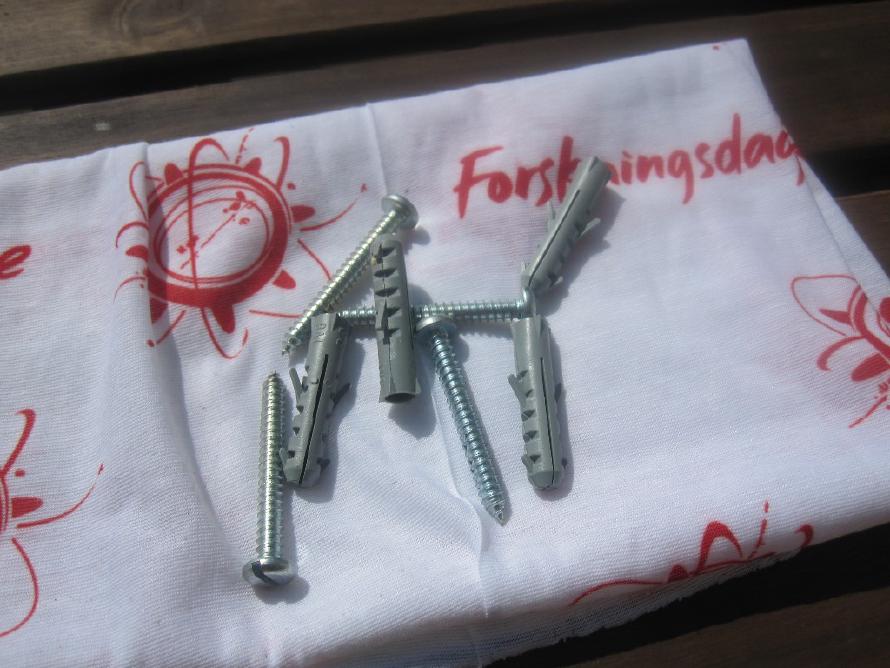(Possibly) How To Attach a Hammock to the Ceiling
Ten years ago I spent three wonderful months in lovely Brazil. One of the most popular pieces of furniture in the country is the hammock and on the last days of the trip, a hammock salesman turned up at our hotel to rip us off. I ended up with a huge, Brazilian style, family hammock, that I probably should have haggled down to half of the asking prize, but after getting used to enjoying the slow pace of the Brazilian life - hammock style - I though it was a great deal.
Unfortunately, I’ve not lived anywhere in the ten years that has passed where it has been possible to install my precious hammock. But all that changed when Anniken and I bought our apartment. The terrace out back is great for hanging a hammock and today I finally got around to attaching the second hook. Ideally, the hammock should be attached to the walls, but the terrace is too wide - a classic first world problem right there - so the concrete ceiling had to be used. Most surprisingly, the hammock didn’t come down when I laid down in it for the first time. In the following entry, I’ll try to explain how you, too, can attach your own hammock when the only support you have is a concrete roof.
But before we start, understand this:
Warning: I’ve never actually bolted anything this potentially heavy (the hammock itself + two people) to a concrete ceiling. Or to anything else, for that matter. Because of this, I have no idea if I’m doing it right or if I’ve simply created a death trap. Hence the “possibly” in the title of this entry. So if you follow these instructions and the hammock comes crashing down with you and your beloved family in it, breaking butts and cracking skulls, it’s your own fault and you take full responsibility for being the moron you are who followed this amateurish guide. Please don’t sue me, Americans.
Also, if I’ve done any horrendous errors, please let me know so I can correct them before anyone get hurt. With that over with, put on your hardhat, dig out the hammer drill from the garage and get ready to do some hands on home improvement!
To hang the hammock, I used two hooks that I attached with four wall plugs each. The screws that came with the hammock looked a bit like wood screws to me, but what the hell do I know? Besides, I figured since I bought everything in Brazil, it was probably safe - their houses are almost exclusively made from concrete, so why would the guy sell me screws for wood? You should ask someone who knows what they are talking about to make sure you get the correct size screws and wall plugs to support the weight of the hammock and the people you plan to place in it. The screws I used were about 7 cm (~3 inches) long and 6 mm (~0.23 inches) wide.
Before you fire up the hammer drill, it’s important that you know where to drill. I didn’t know the first thing about hammock installation, so I did what I always do when I feel dumb - I consulted the collective wisdom of the internet. On this I found a paragraph stating that “minimum hanging distance for hammocks without spreader bars is two thirds of the overall length of the hammock” and that the “maximum hanging distance should be 24″ [~61 cm] more than the minimum hanging distance”. Lay the hammock on the floor and use that as a template to mark on the ceiling where you will drill your holes.
If you don’t have heavy duty drill bits for masonry drilling, now is a good time to drive to a hardware store and get some - and don’t skip on the quality. I drilled the first four holes with budget masonry drill bits and it was a nightmare. I eventually managed to drill four holes, but the drill bits came out cracked and smoking. It might also be a good idea to make sure that you won’t drill through any reinforcing bars. To search for rebars, you can use a stud finder. My own stud finder detected rebars everywhere so in my case it was pretty much useless, but maybe you have better luck. In terms of type of drill, make sure you use a proper hammer drill. Those sissy battery drills will get you absolutely nowhere.

The next thing to think about is safety. Drilling in concrete will result in a lot of dust, so make sure you’re wearing a mask. Also, protect your eyes, you don’t want to get pieces of concrete wedged in there. Last, but not least, the hammer drill will make a hell of a lot of noise, and if you’re doing your drilling in a confined space, you’ll go deaf. One of the things you’ll do in your hammock is to listen to the birds sing, so you want to make sure you take good care of your hearing. But fear not, you don’t need professional safety gear. I used a bandanna to cover my nose and mouth, my swimming goggles for eye protection and your classic run-of-the-mill fitting foam ear plugs.

When you drill, apply a steady amount of force to the hammer drill. The holes should have just enough room for the wall plugs and when the holes are done, beat the wall plugs in with a hammer. Then attach the hooks with the screws. I used the drill for this, too, by applying a screwdriver bit and running the drill in low gear to make sure I managed to tighten the screws properly. Now all you need to do is to repeat everything for the second hook and your new hammock heaven will be ready for its grand opening.
The whole process will be noisy and dusty, but everything is worth it in the end. You’ll have a great place to relax this summer. All you’ll need is your favourite book (may I suggest Frank Herbert’s Dune) and a great drink and you’ll be good to go.
I might look at peace, but to be perfectly honest, I don’t feel too safe in the hammock yet. I simply don’t trust my own home improvement skills - should probably have some friends over who can test it.
Other hammock resources:
Feedback
Do you have any thoughts you want to share? A question, maybe? Or is something in this post just plainly wrong? Then please send an e-mail to vegard at vegard dot net with your input. You can also use any of the other points of contact listed on the About page.
Like your safety outfit :-)
Thank you! I didn’t have professional gear, so I had to improvise. It’s probably also possible to rob a bank with that outfit.
How did it hold up?
We moved out of the apartment where this was done a few years ago, but at least it didn’t fall down while we lived there.


